2015 Indian Scout First Ride Review

Embracing the spirit of the Scout
In recent years, the cruiser market has been caught up in chasing the perception of authenticity or heritage or history or whatever buzzword you care to use, but regardless of the name attached to it, the result has mostly come in the form of the motorcycle’s styling. While it’s nice to call on the past – and it certainly shouldn’t be ignored – there comes a point where the current retro styling exercises risk crossing over into a caricature of the very thing they’re trying to evoke.
2015 Indian Scout
| Engine | 18.0/20 |
| Suspension/Handling | 12.25/15 |
| Transmission/Clutch | 8.75/10 |
| Brakes | 8.25/10 |
| Instruments/Controls | 3.75/5 |
| Ergonomics/Comfort | 8.5/10 |
| Appearance/Quality | 9.25/10 |
| Desirability | 9.0/10 |
| Value | 8.5/10 |
| Overall Score | 86.25/100 |
Indian Motorcycle has clearly thought about this with the models it has released since the relaunch of the marque. As Gary Gray, Indian Motorcycle Product Director, said, “Last year was very purposeful, in that, we needed to earn the right to change the brand. So, how do you earn the right? You pay the deepest respects you can for the brand, and you pay honor to the people that came before you, and you build a bike that people clearly will see as an Indian.” With that statement in mind, how does a company with a true historic – not manufactured – lineage pay homage to the equity in its name without becoming mired in the past?
Indian has decided that, in order to secure future growth, the company must view itself through the lens of where would it be stylistically and technologically had it remained in production continuously since 1901 instead of being essentially shuttered from 1953–2013. According to Gray, “We see the Scout as our first opportunity to say, ‘Now it’s time to honor the brand in the way only the brand itself can, to take it and evolve it, to make it grow and to bring it forward.’ The Scout is the first step forward in progressing the brand and making it the Indian Motorcycle of today, not the Indian Motorcycle of 1953.”
The Scout stands as the first real example of what we might expect in the future from Indian. Rather than chase the look of one of the Scout models released between 1920s–1940s, Polaris’ engineers and designers focused the development on the essential elements that made the Scout a Scout.
The Spirit of the Scout
So, what were the key ingredients? The original Scout was built in response to claims that the motorcycles of the day were getting too big and heavy. (Sound familiar?) In short, the essence of the Scout was a small, light, great-handling motorcycle with a powerful engine. The success of this formula is illustrated by the number of years that these bikes were campaigned on racing circuits. For example, the Sport Scout was produced from 1934–1942, amassing over 20 AMA Grand National titles through the famed “Wrecking Crew” and remained competitive in AMA Grand Nationals until the late 1960s. Also, let’s not forget Burt Munro’s land speed records at Bonneville aboard a hand-crafted streamliner based on a 1920 Indian Scout.
Folks who were most surprised by the shift from the physical heritage to a more spiritual one on the 2015 Scout after its unveiling would probably point to the the engine’s liquid-cooling (although some might also reference the modern styling). Polaris set for itself a goal of 100 hp, and the lightest, most efficient way to manage the heat generated by this power delivery is through liquid-cooling. For those who think it’s not necessary, take a look at the power offered by the other V-Twin cruisers in the displacement range (and above, for that matter) of the Scout’s 1133cc engine, and you’ll see what makes the Scout’s mill special.
Utilizing a 60-degree V-Twin configuration, the Scout generates power through a 99mm x 73.6mm bore and stroke fed by dual overhead cams and 4-valves per cylinder. A 60 mm ride-by-wire (RbW) throttle body feeds the combustion chambers. Dual exhausts connected via a crossover mid-stream handle the spent gasses, while a closed loop EFI sniffs out the mixture via an oxygen sensor for each pipe.
To minimize driveline lash, the clutch basket is directly connected to the crankshaft by gears (as is the clutch in its big brother, the Thunderstroke 111), while vibrations are quelled by a counterbalancer. Whereas most cruisers in this class have five speeds, the Scout’s gearbox gives the rider six cogs, dropping the rpm on the highway. Another gearing difference worth noting is the tallness of the ratios which make it possible to cross into triple-digit speeds in third gear yet have the tachometer loafing along at 3,750 rpm at 70 mph in sixth. The engine’s eager personality is enhanced by minimal flywheel effect – though that does mean launches require a little more care with the clutch release.
What this all adds up to is a quick-revving V-Twin with claimed 100 hp at 8,100 rpm and 72 ft.-lb. of torque at 5,900 rpm. Said Motorcycle Product Director Gray in the Scout press briefing, “This is a cruiser; it feels like a cruiser. Your brain will tell you to shift at 5,000 rpm, but the redline is closer to 9,000 rpm than 5,000 rpm. So, keep pushing the rpm up, and you’re going to feel the bike come alive.”
The mechanics of the engine are only part of the story, though. The engine’s style adds to the purposeful, modern look of the Scout. Without a single cooling fin – faux or otherwise – the shape of the engine’s components, like its structural ribbing, according to Rich Christoph, Senior Industrial Designer, reflect the purpose of its underlying structures. Christoph says honesty and simplicity is a core value of Indian and rhetorically asks “Why hide the beautiful mechanical nature of what the engine is?”
In an effort to distill the chassis’ components down to their most essential construction, Christoph and his team avoided unnecessary covers, saying they added weight, complexity and cost. All of which leads to details like the radiator shrouds being cast as part of the frame. Similarly, where other manufacturers might cover the supporting architecture of the seat’s mount to the frame, the Scout’s seat rides on top of the frame’s cast plates, as do the top shock mounts which bolt directly to them. The structural components become the covers. “When you’re thinking about the frame and those kind of details,” said Christoph, “you want to showcase each part’s function and its form to emphasize the structural rhythm that travels through the bike.”
This aesthetic plays out in the Scout’s “rigid triangle” that links the rear axle to the steering head and the front axle. The way the shocks connect to the swingarm mimic the lines of the original Scout’s struts, and the lines are carried through the shape of the tank to the steering head and to the front axle, giving the 2015 Scout a modernized family resemblance. Similarly, the contemporary monotube, gas-filled coil-over shocks – though playing a different role – harken to the early Indian’s spring-supported seat.
Design in Motion
If the lines of the Scout were meant to give it the impression of movement, the balance of the bike and how it carries its weight emphasize lightness. Just lifting the Scout off of its side stand for the first time makes it feel shockingly light. “We set out to build a bike that was really easy to learn how to ride on,” Gray continues, saying that “dripping wet this bike is 558 lb.” Because of this design goal, the balance and the power delivery combine to give confidence to a newer rider.
The engine’s power delivery was massaged to deliver unintimidating and manageable thrust in the lower revs while still having ample power on tap to be utilized by more experienced riders. Some people have questioned the logic of saying a 100 hp motorcycle was designed for novice riders, but it’s the way the power is delivered, how it is meted out, that supports Indian’s claim of novice-friendly performance. The Scout’s 26.5 in seat height and easy-to-modulate clutch with a reasonably light lever pull make the bike easier to handle for less experienced riders.
Once under way, the bike feels even lighter than 558 lb. Low-speed maneuverability is a breeze – though the turning radius is large enough to make a U-turn on a two-lane road a challenge (but only motojournalists have to perform that task repeatedly). Shifting is quietly positive with none of the clanks or clunks that many cruisers exhibit. Out on the road, the riding position is decidedly cruiserish with the feet forward.
However, the stretch isn’t too long and is quite comfortable for a 32-in. inseam. Riders with substantially longer or shorter limbs can opt for accessory seats, peg relocators and handlebars. With the factory accessories, Indian says it can accommodate riders ranging from 5’ 0” to 6’ 4”. The handlebar, while not so wide as to turn the rider into a sail at highway speeds, is wide enough to give ample leverage for initiating turns. For our average-to-long-waisted 5’ 11” tester, the Scout’s riding position was ideal for riding a sporty, naked cruiser in any situation. A passenger package, which includes a pillion and pegs, is available for those who want to share the ride.
In the lower rpm, the engine is exceptionally smooth, rolling on willingly and accepting varied throttle inputs without a hiccup. The tallness of the gearing was a bit surprising, with second gear being a viable option for speeds ranging from about 20 mph up to speeds over the legal limit in most places. For extended cruising, the vibration that begins to creep in around 5,000 rpm and the gas mileage you’ll want to milk out of the small 3.3-gallon tank say that you’ll probably keep the engine in its mid-range. With a torque curve that peaks at 5,900 rpm, the Scout’s acceleration feels like you’d expect a V-Twin engine to feel as it begins to reach top of it rev range. The beginning of the vibration only supports that impression. While many riders may want to shift at this point to continue on in laid-back cruiser mode, in situations where the pilot desires a sporty ride, the Scout can deliver – impressively.
Cranking on the right grip in the healthy mid-range above 5,000 rpm will put a smile on even the most jaded throttle jockey’s face. Power continues to build all the way up to just before the soft rev-limit kicks in somewhere around 9,000 rpm. (It’s difficult to say where because the digital tachometer lags during hard acceleration, and we were having too much fun to tip-toe up to the limiter to get an accurate reading. Sometimes we can’t maintain our professionalism and gather the data. Sorry.) Vibration begins between 5–6k and builds with the rpm numbers, but unless you really want to rev the snot out of the engine, the motivation provided from 6,000 to 8,000 rpm is ample enough to dispatch any slower traffic which insists on going the speed limit (or below, God bless ‘em) without drama.
In those situations, you’ll be glad the single 298mm disc and two-piston caliper provide better braking power than the spec sheet would imply. One would think that hauling 700+ lb. of rider and motorcycle down from elevated speed would require dual discs (and, yes, we’d prefer the duallies), but the reality is that the front brake is powerful enough to make the rubber howl during maximum braking from 70 mph. We’ve ridden cruisers with twin front discs that require more effort to stop than the Scout’s single one. The same can not be said about the similarly sized (though squeezed by a solo piston) rear brake. Part of this comes from the pedal’s need to be pressed far enough down that the rider’s toes are pointing forward and reducing the leverage on the pedal.
Also, we were a little surprised that ABS isn’t yet available on the Scout. Antilock brakes will be fitted to Euro models to meet pending EU regulation when the Scout makes its way across the pond early in 2015, so we expect ABS to eventually be be added as an option in North America.
Tilting at Horizons
Cruisers – particularly those with forward-mounted controls – have a tempestuous relationship with cornering clearance. Fortunately, the Scout is not one that has its performance envelope overly restricted by dragging hard parts. Yes, the pegs will drag when cornering with alacrity, but the small percentage of cruiser riders who like to go that fast already know to feel out the amount of lean available.
That said, the Scout corners quite well, and when the pegs do start to drag, the hard, non-folding parts are still a ways off. When pressed into the speeds that the third and fourth gears are capable of delivering (you do the math) on smooth pavement, the chassis only betrays that its job description is being exceeded by beginning a gentle undulation (where the front and rear tires don’t feel like they’re tracking the same paths) that says the frame and 41mm fork are starting to flex. Rippling pavement lowers the threshold where these symptoms occur.
Folks who live in areas that have pavement as smooth as that around Sturgis need not worry about the rear suspension’s mere 3 in. of travel. Rounded bumps are handled quite well. When we finally stumbled upon some broken pavement that more accurately resembles the environment faced by urban riders, the shortness of travel reveals itself in the form of harshness – particularly on sharp-edged bumps or potholes – that gets transmitted to the rider’s butt and spine. All-in-all, Indian gets decent performance out of three inches.
When the road came up to kick us in the ass was about the only time we noticed just how firm the solo saddle padding is. The shape and location of the seat locks the rider into essentially one position, but the position is a comfortable one for most riders. (Remember, Indian will be happy to help you tune your riding position through the aforementioned bar, peg and seat options.) In a day of riding that ranged from walking pace in rally traffic to interstate drones to cornering shenanigans that are best left unmentioned, the seat proved quite comfy.
The other threes in the spec sheet that raised our collective eyebrows were the 3.3 gallons that the tank is capable of holding. While the Scout won’t be competing with any tourers when it comes to tank-draining stints, our day’s ride yielded an average of 45.1 mpg – with lots of time spent at elevated rpm in lower gears, flexing the engine’s muscles. So, a 150-mile range or slightly higher is a reasonable expectation.
Our short time with the Scout has only whet our appetite to play with it some more, and judging from the comments in our preview article, we’re not the only ones who are excited. Unfortunately, the 2015 Indian Scout won’t be available until the end of 2014, which will allow for plenty of time for prospective buyers to select their color. While the Indian Motorcycle Red that we rode in South Dakota was nice, the semi-matt finish of the Silver Smoke and Thunder Black Smoke look stunning in three dimensions, and all three of those colors can be had for $11,299. The glossy Thunder Black will be $10,999. Meanwhile, we’ll be figuring out what cruisers to pit against the new kid to see how well it plays with others or whether it simply kicks butts and takes names.
In closing, since Indian released four different models based on the same platform over the past year, we asked Gary Gray the obvious question: Where is this new engine and chassis going to take the company? While he predictably kept his cards pretty close to his chest, we’ll just let him have the last word while we imagine the possibilities:
“As we concepted this vehicle, there are five, 10 other vehicles we can build off of it, but some of them, certainly, as most things do, will go away. We started at the sweet spot with this one, and there’s lots of room to go many directions from where we’re at.”
+ Highs
- Power way beyond where you’d expect it in a V-Twin cruiser
- Liquid-cooling!
- Modern styling with a classic line
– Sighs
- Engine vibration at high rpm
- 3.3 gallon tank
- Not available until the riding season is over

Like most of the best happenings in his life, Evans stumbled into his motojournalism career. While on his way to a planned life in academia, he applied for a job at a motorcycle magazine, thinking he’d get the opportunity to write some freelance articles. Instead, he was offered a full-time job in which he discovered he could actually get paid to ride other people’s motorcycles – and he’s never looked back. Over the 25 years he’s been in the motorcycle industry, Evans has written two books, 101 Sportbike Performance Projects and How to Modify Your Metric Cruiser, and has ridden just about every production motorcycle manufactured. Evans has a deep love of motorcycles and believes they are a force for good in the world.
More by Evans Brasfield



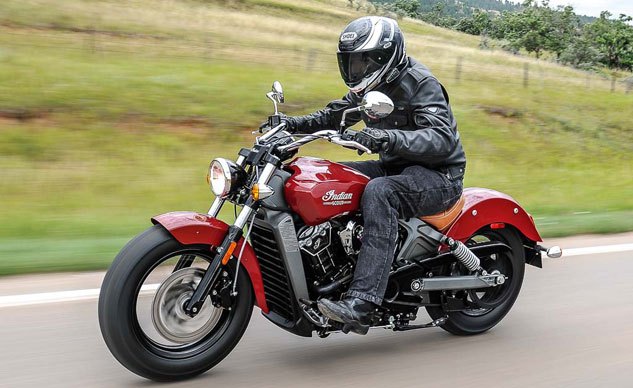
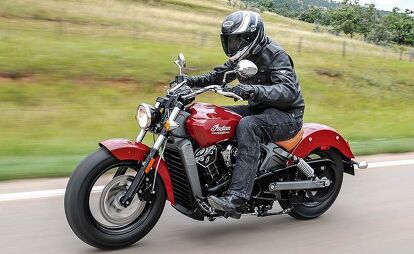

































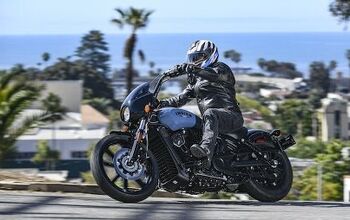
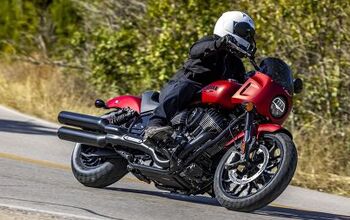
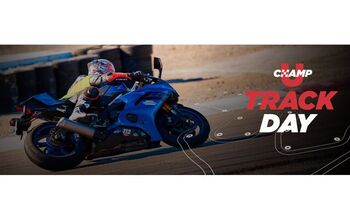

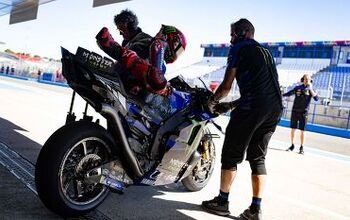





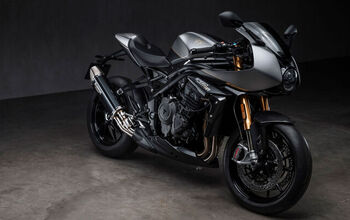





Comments
Join the conversation
Took delivery of a Scout 4 days ago, and so far it's winner. I'm enamored, that's for sure. Right now it's stock, so I am breaking it in for my wife. Once broken in, we are due to install all the available reduced reach hardware for her 5' frame. I'm 6' and 240#, and the stock setup works great. Compliant suspension, and no bottoming out. Smooth engine and transmission. Anyone considering a Dyna (and we owned one for years), needs to shop the Scout. And Sportster??? Compared to the Scout, the Sportster is a joke (we owned one of those too for a few years). Indian did very well, for sure.
I like it. It is a departure from all of the run-of-the-mill Harley copy cruisers from so many manufacturers. I don't plan on getting rid of my HD Street Rod, but I may very well add a Scout to the stable.